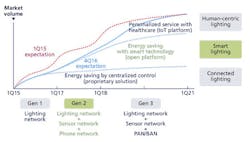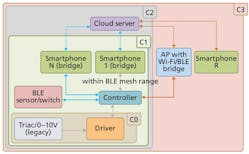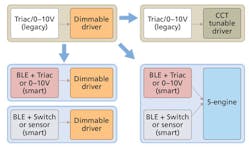An evolution from connected lighting to smart lighting to human-centric lighting is underway, writes KYEONGIK MIN, and the industry will require open platforms for commercial success.
For the past two decades, LEDs have steadily progressed from use in traditional standalone bulb lighting to integral luminaire system designs and now to digital LED systems including connected or networked lighting, smart lighting, and human-centric lighting (HCL). The incredible evolution has been made possible by the fact that LEDs are solid-state lighting (SSL) sources. However, the commoditization of LEDs and LED modules has slowed the technological advancements of LED lighting in the face of fierce competition. For years, the industry was focused more on cost than design excellence, but the pendulum has now shifted to placing greater emphasis on developing more advanced LED lighting designs. Let's discuss how we can accelerate these technology-focused transitions with a deeper understanding of current market issues to embrace the full potential of smart lighting and the Internet of Things (IoT).
Interested in articles & announcements about lighting control & smart lighting?
FIG. 1. The chronology of the digital lighting transformation shows overlapped applications.
Recently, many lighting companies have been introducing their own connected lighting solutions. The finest of these solutions might continue to improve some market positioning for leading LED lighting manufacturers by demonstrating what is clearly greater value in certain bellwether applications. However, for the lighting industry to continue growing rapidly, open-platform interoperability standardization is crucial for the vast majority of connected applications. Moreover, the cost of transitioning from traditional to digital lighting must be further lowered as the technology is more closely tied to market benefits. As covered in a prior LEDs Magazine article, the technology industry is struggling somewhat to realize potential IoT benefits.
The evolution of lighting control
The future of digital lighting is taking shape in a three-phase transformation (Fig. 1). The transformation is coming in the form of connected lighting, smart lighting, or HCL (also referred to as lighting for health and wellbeing). As of early 2015, these areas of transformation seemed very distinct, but now there is significant overlap.
Over the past decade, major lighting manufacturers and control system companies have developed several proprietary solutions for increasing energy savings through centralized control, based on wired or wireless connectivity technology. The primary purpose of first-generation solutions has been to build a lighting network that focuses on connecting lighting products. This simple approach will continue for some time, but it will not grow in popularity because fixture manufacturers are generally reluctant to adopt proprietary solutions for their digital lighting conversions. These solutions do not allow adequate scale or sufficient interoperability with evolving network technologies such as advanced sensor networks, next-generation phone networks, and PANs (personal area networks)/BANs (body area networks).
Energy savings with smart technologies based on an open platform approach has allowed small- and medium-sized lighting manufacturers and control system companies to maximize smart device interoperability, primarily regarding wireless technologies. The purpose of such second-generation solutions has been to standardize communication protocols and reduce the pain of commissioning and pairing, where smartphones serve as the primary smart device and user interface. In addition, the convergence of sensor and actuator networks (SANs) has created another valuable approach to enhancing the augmented network. ZigBee and Bluetooth Smart technology are key solutions for driving this new generation of digital lighting.
The ultimate goal of digital lighting is to develop a hub for the IoT that delivers additional network capabilities to PANs/BANs. In the early years of digital lighting (around 2005), the number of smart devices was equal to the number of people across the globe. But now, almost everyone has a couple of mobile devices and by 2020, the average user will have several smart devices at work and home. This trend will also lead to a shift in the smart lighting network infrastructure to embrace the personalization of naturalized healthcare service. The third generation of digital lighting will require an IP (Internet Protocol) address for every node and end-to-end security architectures that can secure personal data with hardware, firmware, and/or software. The essence of human-centric illumination arises from the physical and biological nature of light, and will be further enhanced when coupled with white-CCT tunable and color-tunable LED technology.
FIG. 2. Three levels of hierarchy distinguish lighting control using smartphones.
A simple, open-platform-based, smart lighting methodology that complements the connectivity of connected light and bridges to HCL can be based on the current open platform. Indeed, HCL should be built on the same platform other than allowing for the use of more sophisticated spectrum control and additional network devices in PANs/BANs.
Implications of smartphone control over lighting
The importance of smartphones and related electronic device technologies will grow dramatically over time. These technologies will become the hub for massive amounts of information sharing that increases user awareness and improves network communications. When we control lighting, we typically use switches, sensors, and wall controllers that have been optimized for traditional lighting or low-level digital lighting in its early stages. However, people increasingly want to monitor the status of remote devices and control them with smartphones from a distance, even when they are out of sight.
The second key point related to lighting control with smartphones is that Bluetooth technology has evolved to also accommodate smart technology, with Bluetooth Low Energy (BLE). Bluetooth is quite different from ZigBee technology, which does not support direct control with smartphones. ZigBee is at the center of much IoT activity today, especially at the end node. But while BLE will support mesh technology together with direct control for IoT applications, ZigBee will not. This control is important for high-density end-node applications such as smart homes and as a result, BLE will soon be standardized.
The third critical point is that a smartphone can become an access point to the cloud by 3G, 4G, LTE data network, or Wi-Fi, which can allow near-instant data analysis and massive utilization of real-time services remotely. This evolution is one of the key features of healthcare services with authentication by password or biometrics. In terms of security and flexibility in the use of information services, smartphone control will be more widely developed for personalized service on demand, which will make the payment process much easier and more secure.
FIG. 3. Seamless options exist for a step-by-step approach to C1 control.
Also of major importance is the fact that we need to share space and assets including the lighting used by building occupants. In smart homes, family members need to be able to easily control home appliances and security devices, regardless of their physical location, whether they lie in direct range or require a remote control. To accomplish this, the pairing necessary for Bluetooth connectivity needs to become a much more convenient process.
Hierarchy of smartphone control over lighting
Let's now examine the hierarchy of smartphone control over lighting. This discussion will be based mainly on BLE technology because of its tremendous potential and the strong reception that it has received throughout the industry.
In the case of connected lighting, the lights in residential or commercial spaces are generally controlled by a triac or 0-10V dimmer, which gives the control signal to the driver of the LED module in each luminaire.
Not so with lighting that is smartphone controlled, where the hierarchy of smartphone controls generally can best be described in three tiers: C1, C2, and C3, and in most cases as compared to C0, a legacy control solution already in use (Fig. 2). Optionally, a dedicated controller can be added to the existing driver with a BLE-equipped sensor or switch on top of the C0 to permit direct control without the need for a cloud server. In this C1 mode, multiple smartphone controls allow users to share lighting control with one other.
To further control lights in common and have them synchronized at the cloud level, the C2 solution can report all control data and sensed data to the cloud and to record all analyzed data provided by the cloud. The data that is generated can be easily monetized on a subscription basis.
To control a smart device or appliance at anytime and anywhere, a Wi-Fi/BLE bridge can be quickly added to control lighting through the cloud within the BLE mesh range. In many cases, a consumer may want to control lighting or appliances when outside to confirm their status, prepare to take care of something remotely, or to set up the most desirable configuration in a smart space. It can be done in the C3 control mode.
Prerequisites for a prosperous smart lighting era
There are significant challenges in completely transforming the industry from traditional to digital lighting. In fact, some say that the window of opportunity for doing this with most lighting projects will only last from now until early 2018.
Considering that today's steadily increasing LED penetration rate has been triggered by the cost-lowering commoditization of LEDs, attempts to accelerate the open-platform transition from traditional lighting to connected lighting or smart lighting makes great sense. However, connected lighting as a proprietary solution has not been welcomed by end users due to its unacceptable cost.
It is therefore necessary to address these key prerequisites for achieving a high level of prosperity in the smart lighting era. The industry needs an open platform based on industry-wide standardization. And it needs an acceptable cost with a broad range of user benefits.
FIG. 4. A BLE-enabled solution and BLE/ZigBee combo solution will happen in sequence.
To meet these necessary prerequisites, the standardization of DALI (digital addressable lighting interface), ZigBee, and Bluetooth is already underway due to their vital role as core connecting methodologies for lighting networks, sensor networks, and wireless phone networks. Most upcoming solutions will be based on standardized hardware and firmware so that all players in the digital lighting industry can take part in the development of viable end-to-end solutions. Beginning in the second half of 2017, most new smart lighting products will be based on DALI 2.0, ZigBee 3.0, and Bluetooth 5.0.
FIG. 5. Step-by-step evolution offers clear market relevance.
With the inevitable greater cost savings and increased opportunity for seamless integration, lighting device manufacturers can freely design their own open-platform LED lighting systems and enhance newly installed systems at their discretion. Based on this understanding, Samsung believes the solutions to be demonstrated by leading smart lighting enablers at LightFair International (LFI) 2017 can pave the widest path to highly efficient digital lighting.
Smart lighting examples
Consider trying some examples of seamless smart lighting to reduce decision-maker resistance and accelerate widespread adoption of smart lighting, as described in Fig. 3. In the US, LED lighting manufacturers can install dimmable drivers for improved LED lighting or continue the use of legacy dimmers like triac or 0-10V. With existing LED lighting systems, a BLE enabled dimmer or BLE enabled smart dimmer can be added to replace a triac/0-10V dimmer. This will allow smartphones to incorporate much more flexible use of remote control technology in a residential space.
Similarly, the same technology can be applied to switches and sensors in converting most existing components to smart components, while keeping some in their legacy designs if desired. With a backwards-compatible smart driver, the existing controller can be matched to a new CCT tunable driver. Furthermore, LED modules, drivers, and controllers can be consolidated into a single board (or smart engine called an S-engine) to reduce cost to an acceptable level.
A step-by-step approach to seamless connectivity will be based on BLE-enabled solutions or the use of a BLE/ZigBee combo (combination) solution. By using a BLE/ZigBee combo monolithic solution (a digital IC will be available during the second half of 2017), a simple, cost-effective approach can be easily adopted.
Overall, the advantages for lighting manufacturers in choosing digital lighting are very compelling. To illustrate this visually, the key benefits of each step toward smart digital lighting are shown in Fig. 5. Adding Bluetooth to an existing triac/0-10V architecture requires some increase in cost, but this will be less expensive than adding smart features to existing dimmers. We can save more energy, add BLE to switches and sensors, and analyze the conditions for using smarter controls, while maintaining code compliance.
In addition, the initial investment can become even more cost-efficient by enabling multiple phone controls over any home appliance, especially useful when the controlling device is in a remote-control mode.
Seamless solution based on standardized DALI/ZigBee/BLE protocol
The driving forces for smart lighting and HCL have been carefully evaluated here, as well as how to accelerate their adoption beyond the potential hurdles that have been discussed. Combining a Bluetooth Smart approach (or BLE) with an optimized mesh and seamless end-to-end control options will likely be the most efficient way to transition from connected lighting to HCL, via smart lighting.
Encouraging lighting manufacturers to embrace this approach without worrying about distant future solutions will be key to a prosperous smart lighting era. The early digitalization of LED lighting will be first realized this year based on a seamless options approach. Moreover, DALI/ZigBee/Bluetooth standardization schedules prior to LFI 2017 will be consistent with this important shift, and Samsung will launch end-to-end solutions that will be able to accelerate the transition from smart lighting to HCL in the second half of the year.
DR. KYEONGIK MIN is a principal engineer on the LED business team at Samsung Electronics (samsung.com).










